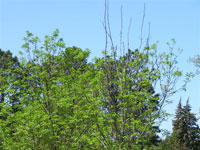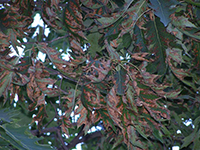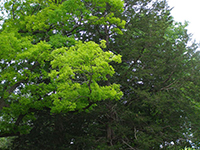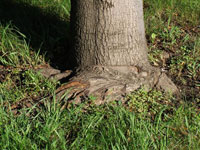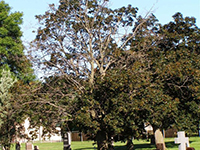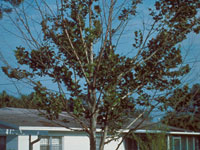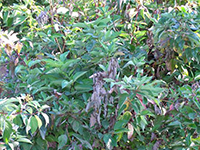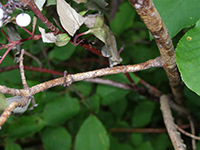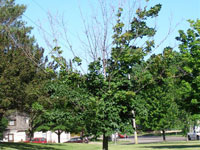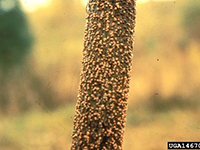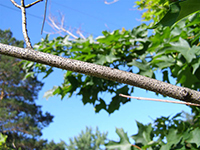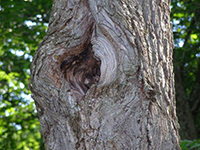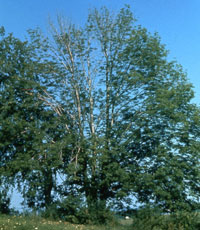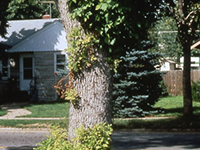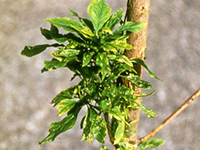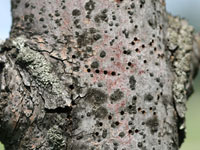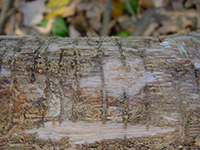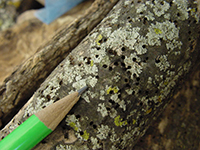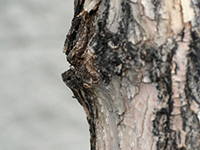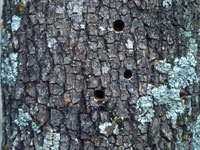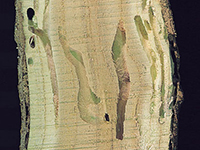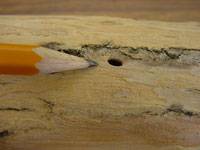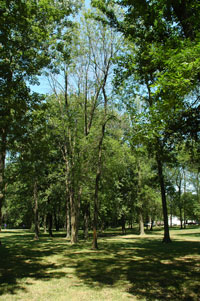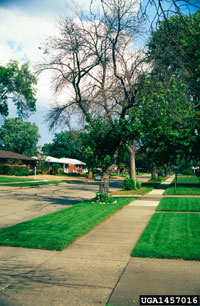Extension > Garden > Diagnose a problem > What's wrong with my plant? > Deciduous Trees > Ash > Dead branches
Ash > Trunk > Dead branches
1 of 11
Environmental stress
Drought, compact soils, flood damage, winter injury, other
- Dead branches in the canopy
- Leaves wilt and turn brown at the tips and the margins first, then completely brown
- Many weak young shoots/sprouts at the base of the tree
- Leaves appear drooped or wilted within canopy
- More information on caring for trees and shrubs
2 of 11
Stem girdling roots
- A root circling the trunk of the tree may be seen at the soil line
- The trunk may become sunken in or compressed where it contacts the root
- If the girdling root is below ground the trunk will lack the natural widening or flare at the soil line, but rather will go straight into the earth like a telephone pole
- Affected trees have slow growth, poor color, change color and lose their leaves early in the fall
- Affected trees commonly exhibit water-stress symptoms such as marginal leaf scorch, wilting, sudden leaf fall.
- Affected trees commonly exhibit excessive and abnormal winter damage including true frost cracks and dieback
- More information on Stem girdling roots
3 of 11
Branch cankers
Botryosphaeria sp. (and other fungi)
- Dead branches and twigs, often first observed in early spring
- Sunken, discolored canker on branches, oval shaped to completely encircling the branch
- Dark stained sapwood visible if bark is cut off of the discolored area of the branch
- Leaves on affected branches may wilt and die
- Small raised black pimple like bumps along edge of the discolored area
- Common on trees stressed by drought, recent transplant or other factors
- More information on canker
4 of 11
Coral spot canker
Nectria cinnabarina
- Dead branches and twigs, often first observed in early spring
- Sunken dark brown area on branch that is often cracked or has a ridge at the edge
- Raised cushion like bumps on affected branches, may be cream to orange or red, turn back with age
- Common on trees stressed by drought, recent transplant or other factors
- More information on canker
5 of 11
Perennial Nectria canker
Neonectria ditissima
- Sunken round to oval cankers with target shaped ridges of barkless wood on large branches or the main trunk
- Small dark sunken area on twigs that can girdle and kill the branch
- Red to reddish orange raised cushion like bumps can occasionally be seen on the edge of the canker
- More information on Perennial nectria canker
6 of 11
Ash yellows phytoplasma
- Infected plants grow very slowly, and have a sparse thin canopy of leaves
- Leaves are small, yellow, often folded or cupped and grow in clumps along the branch
- Branches die throughout the canopy
- Many weak young sprouts with small yellow leaves arise from the base of the tree
- More information on ash yellows
7 of 11
Ash bark beetles
- Exit holes first appear in May in trunks and branches
- Exit holes are 1/8 inch wide and round
- Galleries cut across the grain in sapwood; typically with two arms starting from a central chamber
- Adults are 1/8 inch long and brown
- Larvae are small, about 1/8 inch long, brown head, whitish body, lacks legs; is bent in a C-shape
- More information on Ash bark beetles
8 of 11
Clearwing borers
Ash borer and banded ash clearwing
- Exit holes first appear in June and July
- Exit holes are round and 1/4 inch wide; frass (sawdust and excrement) can be conspicuous underneath
- Galleries occur deep in sapwood
- Pupae stick out of exit hole, empty pupal cases are commonly observed after moths have emerged
- Adults are wasp-like, lacking scales on most of their wings
- Larvae are caterpillars; have brown head and cream-colored body; up to 1 1/3 inch long
- More information on Clearwing borers
9 of 11
Redheaded ash borer
- Exit holes first appear in June
- Exit holes are round and 3/8 inch wide
- Galleries start in phloem and eventually enter into sapwood; generally not very serpentine
- Adults are 1/2 to 5/8 inch long; reddish brown with four yellow bands across their wing covers
- Larvae are up to 4/5 inch long, whitish, cylindrical; area behind head enlarged and round, head generally inconspicuous; legless
- More information on Redheaded ash borer
10 of 11
Flatheaded borers
Primarily Chrysobothris sexsignata
- Exit holes first appear in May and June
- Found nearly always in black ash
- Exit holes are oval shaped and 3/16 inch wide
- Galleries start in phloem and eventually enter into sapwood; generally not very serpentine
- Adults are 1/2 inch long, bullet-shaped, and bronzed colored
- Larvae are whitish, flattened, up to 1 inch long; area behind enlarged and flattened; head generally inconspicuous; legless
- More information on flatheaded borers
11 of 11
Emerald ash borers
- Chewing damage caused by adults occurs late May to early August
- Chews along the edges of leaves; defoliation is typically minor
- Slender bodied, 1/3 - 1/2 inch long; iridescent green with coppery colored head
- More information on Emerald ash borers



